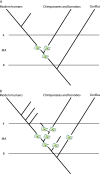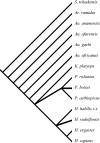The hominin fossil record: taxa, grades and clades
- PMID: 18380861
- PMCID: PMC2409102
- DOI: 10.1111/j.1469-7580.2008.00871.x
The hominin fossil record: taxa, grades and clades
Abstract
This paper begins by reviewing the fossil evidence for human evolution. It presents summaries of each of the taxa recognized in a relatively speciose hominin taxonomy. These taxa are grouped in grades, namely possible and probable hominins, archaic hominins, megadont archaic hominins, transitional hominins, pre-modern Homo and anatomically modern Homo. The second part of this contribution considers some of the controversies that surround hominin taxonomy and systematics. The first is the vexed question of how you tell an early hominin from an early panin, or from taxa belonging to an extinct clade closely related to the Pan-Homo clade. Secondly, we consider how many species should be recognized within the hominin fossil record, and review the philosophies and methods used to identify taxa within the hominin fossil record. Thirdly, we examine how relationships within the hominin clade are investigated, including descriptions of the methods used to break down an integrated structure into tractable analytical units, and then how cladograms are generated and compared. We then review the internal structure of the hominin clade, including the problem of how many subclades should be recognized within the hominin clade, and we examine the reliability of hominin cladistic hypotheses. The last part of the paper reviews the concepts of a genus, including the criteria that should be used for recognizing genera within the hominin clade.
Figures



References
-
- Alexeev V. The Origin of the Human Race. Moscow: Progress Publishers; 1986.
-
- Arambourg C, Coppens Y. Decouverte d’un australopithecien nouveau dans les Gisements de L’Omo (Ethiopie) South Afr J Sci. 1968;64:58–59.
-
- Archie JW. Methods for coding variable morphological features for numerical taxonomic analysis. Syst Zool. 1985;34:326–345.
-
- Asfaw B, White T, Lovejoy O, Latimer B, Simpson S, Suwa G. Australopithecus garhi: a new species of early hominid from Ethiopia. Science. 1999;284:629–635. - PubMed
-
- Bermúdez de Castro JM, Arsuaga JL, Carbonell E, et al. A hominid from the Lower Pleistocene of Atapuerca, Spain: possible ancestor to Neandertals and modern humans. Science. 1997;276:1392–1395. - PubMed
Publication types
MeSH terms
LinkOut - more resources
Full Text Sources

